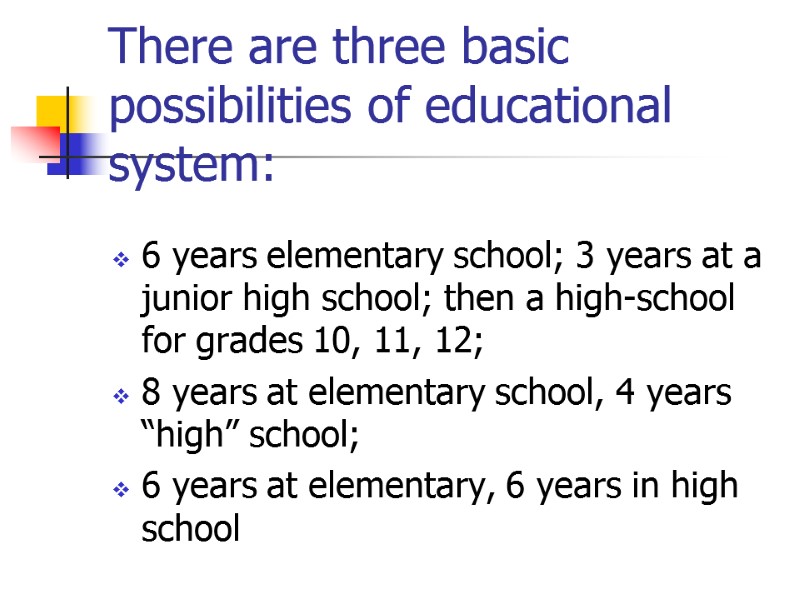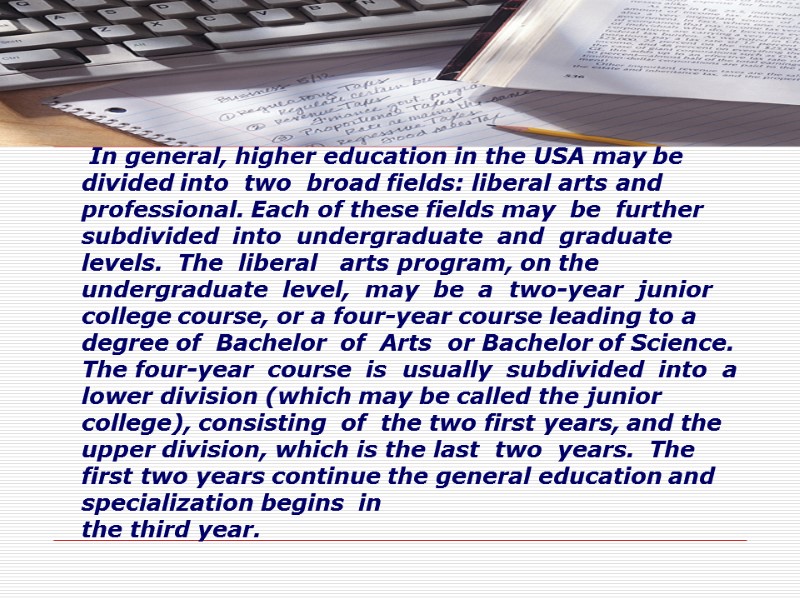Education in the USA The American system of

















11612-education_in_the_usa.ppt
- Количество слайдов: 16
 Education in the USA
Education in the USA
 The American system of school education differs from the systems in other countries. There are state public schools, private elementary schools and private secondary schools. Public schools are free and private schools are fee-paying.
The American system of school education differs from the systems in other countries. There are state public schools, private elementary schools and private secondary schools. Public schools are free and private schools are fee-paying.
 There are the varieties of schools now: public and private, large and small, urban and rural, traditional and experimental, academic, vocational and comprehensive. In USA there are 2 types of schools – public schools, which are supposed by the state and private schools, where the families have to pay special fees. Every child of America is guaranteed up to 13 years of education. 89% of schoolchildren use the public school system General Pattern of Education in the USA
There are the varieties of schools now: public and private, large and small, urban and rural, traditional and experimental, academic, vocational and comprehensive. In USA there are 2 types of schools – public schools, which are supposed by the state and private schools, where the families have to pay special fees. Every child of America is guaranteed up to 13 years of education. 89% of schoolchildren use the public school system General Pattern of Education in the USA
 Steps of education in the USA
Steps of education in the USA
 There are three basic possibilities of educational system: 6 years elementary school; 3 years at a junior high school; then a high-school for grades 10, 11, 12; 8 years at elementary school, 4 years “high” school; 6 years at elementary, 6 years in high school
There are three basic possibilities of educational system: 6 years elementary school; 3 years at a junior high school; then a high-school for grades 10, 11, 12; 8 years at elementary school, 4 years “high” school; 6 years at elementary, 6 years in high school
 Elementary education begins at the age of six or seven, when a child goes to the first grade (form). At the age of sixteen schoolchildren leave the elementary school and may continue their education at one of the secondary schools or high schools, as they call them. The programme of studies in the elementary school includes English, Arithmetic, Geography, History of the USA, Natural sciences and, besides, Physical Training, Singing, Drawing, wood or metal work, etc. Sometimes they learn a foreign language and general history.
Elementary education begins at the age of six or seven, when a child goes to the first grade (form). At the age of sixteen schoolchildren leave the elementary school and may continue their education at one of the secondary schools or high schools, as they call them. The programme of studies in the elementary school includes English, Arithmetic, Geography, History of the USA, Natural sciences and, besides, Physical Training, Singing, Drawing, wood or metal work, etc. Sometimes they learn a foreign language and general history.
 The length of the school year varies among the states. Wide variation exists also in the length of the school day. A common practice is to have school in session from 9:00 to 12:00 in the morning and from 1:00 to 3:30 in the afternoon, Monday through Friday. The school day for the lower grades is often from 30 minutes to an hour shorter. Most schools require some homework to be done by elementary pupils.
The length of the school year varies among the states. Wide variation exists also in the length of the school day. A common practice is to have school in session from 9:00 to 12:00 in the morning and from 1:00 to 3:30 in the afternoon, Monday through Friday. The school day for the lower grades is often from 30 minutes to an hour shorter. Most schools require some homework to be done by elementary pupils.
 The elementary schools tend to be small. The high schools are generally larger and accommodate pupils from four or five elementary schools. A small town generally has several elementary schools and one high school. In some rural communities the one-room country school house still exists. Here may be found from five to twenty-five pupils in grades one through eight, all taught by the same teacher.
The elementary schools tend to be small. The high schools are generally larger and accommodate pupils from four or five elementary schools. A small town generally has several elementary schools and one high school. In some rural communities the one-room country school house still exists. Here may be found from five to twenty-five pupils in grades one through eight, all taught by the same teacher.
 Higher educational institutions usually are governed by a board of regents or a board of trustees. The executive head of a college or a university is usually called the president. The various colleges or schools which take up a university are headed by deans. Within a school or college there may be departments according to subject matter fields, each of which may be headed by a professor who is designated as department head or chairman. Other members of the faculty hold academic ranks, such as instructor, assistant professor, associate professor, and professor. Graduate students who give some part-time service may be designated as graduate assistants or fellows.
Higher educational institutions usually are governed by a board of regents or a board of trustees. The executive head of a college or a university is usually called the president. The various colleges or schools which take up a university are headed by deans. Within a school or college there may be departments according to subject matter fields, each of which may be headed by a professor who is designated as department head or chairman. Other members of the faculty hold academic ranks, such as instructor, assistant professor, associate professor, and professor. Graduate students who give some part-time service may be designated as graduate assistants or fellows.
 The National Government gives no direct financial aid to the institutions of higher education. Students must pay a tuition fee. This creates a finantial hardship for some people. Many of the students have to work to pay their expenses. Americans place a high value on education. That's why Kennedy said, "Our progress as a nation can be no swifter than our progress in education".
The National Government gives no direct financial aid to the institutions of higher education. Students must pay a tuition fee. This creates a finantial hardship for some people. Many of the students have to work to pay their expenses. Americans place a high value on education. That's why Kennedy said, "Our progress as a nation can be no swifter than our progress in education".
 Professional education in fields such as agriculture, dentistry, law, engineering, medicine, pharmacy, teaching, etc. Is pursued in professional schools which may be part of a university or may be separate institutions which confine their instruction to a single profession. Often two, three, or four years of pre-professional liberal arts education are required before admission to a professional school. Three to five years of specialized training lead to professional degrees such as Doctor of Medicine, Bachelor of Law, etc.
Professional education in fields such as agriculture, dentistry, law, engineering, medicine, pharmacy, teaching, etc. Is pursued in professional schools which may be part of a university or may be separate institutions which confine their instruction to a single profession. Often two, three, or four years of pre-professional liberal arts education are required before admission to a professional school. Three to five years of specialized training lead to professional degrees such as Doctor of Medicine, Bachelor of Law, etc.
 Universities in USA There are also 156 Universities in the USA . The largest is the University in California (US); the oldest-Harvard, Yale – (Ivy League colleges) – the name given to a group of highly respected universities in New England; Pennsylvania, Princeton and Columbia were founded in the 17th and 18th centuries.
Universities in USA There are also 156 Universities in the USA . The largest is the University in California (US); the oldest-Harvard, Yale – (Ivy League colleges) – the name given to a group of highly respected universities in New England; Pennsylvania, Princeton and Columbia were founded in the 17th and 18th centuries.
 It usually takes four years to meet the requirements for a Bachelor of Arts or Bachelor of Science degree. A Master of Arts or Master of Science degree may be obtained in one or two additional years. The highest academic degree is the Doctor of Philosophy. It may take any number of years to complete the original research work necessary to obtain this degree.
It usually takes four years to meet the requirements for a Bachelor of Arts or Bachelor of Science degree. A Master of Arts or Master of Science degree may be obtained in one or two additional years. The highest academic degree is the Doctor of Philosophy. It may take any number of years to complete the original research work necessary to obtain this degree.
 In general, higher education in the USA may be divided into two broad fields: liberal arts and professional. Each of these fields may be further subdivided into undergraduate and graduate levels. The liberal arts program, on the undergraduate level, may be a two-year junior college course, or a four-year course leading to a degree of Bachelor of Arts or Bachelor of Science. The four-year course is usually subdivided into a lower division (which may be called the junior college), consisting of the two first years, and the upper division, which is the last two years. The first two years continue the general education and specialization begins in the third year.
In general, higher education in the USA may be divided into two broad fields: liberal arts and professional. Each of these fields may be further subdivided into undergraduate and graduate levels. The liberal arts program, on the undergraduate level, may be a two-year junior college course, or a four-year course leading to a degree of Bachelor of Arts or Bachelor of Science. The four-year course is usually subdivided into a lower division (which may be called the junior college), consisting of the two first years, and the upper division, which is the last two years. The first two years continue the general education and specialization begins in the third year.
 Princeton Harvard Yale
Princeton Harvard Yale
 Thank you for your attentions
Thank you for your attentions

